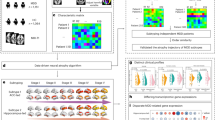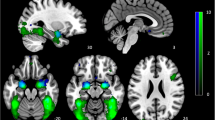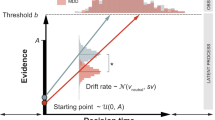Abstract
Alterations in processing of emotionally salient information have been reported in individuals with major depressive disorder (MDD). Evidence suggests a role for noradrenaline in the regulation of a cortico-limbic-striatal circuit that has also been implicated in the pathophysiology of MDD. Herein, we studied the physiological consequences of a common coding polymorphism of the gene for the α2C-adrenoreceptor (AR) subtype—the deletion of four consecutive amino acids at codons 322–325 of the α2C-AR (α2CDel322–325-AR) in medication-free, remitted individuals with MDD (rMDD), and healthy control subjects. After injection of 10 mCi of H215O, positron emission tomography (PET) measures of neural activity were acquired while subjects were viewing unmasked sad, happy, and fearful faces. The neural responses to sad facial expressions were increased in the amygdala and decreased in the left ventral striatum in rMDD patients relative to healthy control subjects. Furthermore, we report that rMDD carriers of one or two copies of the α2CDel322–325-AR exhibit greater amygdala as well as pregenual and subgenual anterior cingulate gyrus neuronal activity in response to sad faces than healthy α2CDel322–325-AR carriers and rMDD noncarriers. These results suggest that the α2CDel322–325-AR confers a change in brain function implicating this α2-AR subtype into the pathophysiology of MDD.
Similar content being viewed by others
Log in or create a free account to read this content
Gain free access to this article, as well as selected content from this journal and more on nature.com
or
References
Abercrombie HC, Larson CL, Ward RT (1996). Metabolic rate in the maygdala predicts negative affect and depression severity in depressed patients; an FDG-PET study. Neuroimage S217.
Barnes RF, Veith RC, Borson S, Verhey J, Raskind MA, Halter JB (1983). High levels of plasma catecholamines in dexamethasone-resistant depressed patients. Am J Psychiatry 140: 1623–1625.
Callado LF, Meana JJ, Grijalba B, Pazos A, Sastre M, Garcia-Sevilla JA (1998). Selective increase of alpha2A-adrenoceptor agonist binding sites in brains of depressed suicide victims. J Neurochem 70: 1114–1123.
Calogero AE, Gallucci WT, Chrousos GP, Gold PW (1988). Catecholamine effects upon rat hypothalamic corticotropin-releasing hormone secretion in vitro. J Clin Invest 82: 839–846.
de Villiers AS, Russell VA, Carstens ME, Aalbers C, Gagiano CA, Chalton DO et al (1987). Noradrenergic function and hypothalamic–pituitary–adrenal axis activity in primary unipolar major depressive disorder. Psychiatry Res 22: 127–140.
Drevets WC (1998). Functional neuroimaging studies of depression: the anatomy of melancholia. Annu Rev Med 49: 341–361.
Drevets WC, Gautier C, Lowry T, Bogers W, Greer P, Kupfer D (2001). Abnormal hemodynamic responses to facially expressed emotion in major depression. Soc Neurosci Abstr 31.
Drevets WC, Videen TO, Price JL, Preskorn SH, Carmichael ST, Raichle ME (1992). A functional anatomical study of unipolar depression. J Neurosci 12: 3628–3641.
Eisenhofer G, Friberg P, Rundqvist B, Quyyumi AA, Lambert G, Kaye DM et al (1996). Cardiac sympathetic nerve function in congestive heart failure. Circulation 93: 1667–1676.
Ekman P, Friesen WV (1976). Pictures of Facial Affect. Consulting Psychologists: Palo Alto.
Elliott R, Rubinsztein JS, Sahakian BJ, Dolan RJ (2002). The neural basis of mood-congruent processing biases in depression. Arch Gen Psychiatry 59: 597–604.
Feng J, Zheng J, Gelernter J, Kranzler H, Cook E, Goldman D et al (2001). An in-frame deletion in the alpha(2C) adrenergic receptor is common in African-Americans. Mol Psychiatry 6: 168–172.
First MB, Gibbon M, Spitzer RL, Williams JBW (1996). Structured Clinical Interview for DSM-IV Axis I Disorders: Nonpatient Edition (SCID-I/NP). Biometrics Department, New York State Psychiatric Institute: New York.
Frank E, Prien RF, Jarrett RB, Keller MB, Kupfer DJ, Lavori PW et al (1991). Conceptualization and rationale for consensus definitions of terms in major depressive disorder remission, recovery, relapse, and recurrence. Arch Gen Psychiatry 48: 851–855.
Fu CH, Williams SC, Cleare AJ, Brammer MJ, Walsh ND, Kim J et al (2004). Attenuation of the neural response to sad faces in major depression by antidepressant treatment: a prospective, event-related functional magnetic resonance imaging study. Arch Gen Psychiatry 61: 877–889.
Lambert G, Johansson M, Agren H, Friberg P (2000). Reduced brain norpienephrine and dopamine release in treatment-refractory depressive illness: Evidence in support of the catecholamine hypothesis of mood disorders. Arch Gen Psychiatry 57: 787–793.
Lawrence NS, Williams AM, Surguladze S, Giampietro V, Brammer MJ, Andrew C et al (2004). Subcortical and ventral prefrontal cortical neural responses to facial expressions distinguish patients with bipolar disorder and major depression. Biol Psychiatry 55: 578–587.
Liotti M, Mayberg HS, McGinnis S, Brannan SL, Jerabek P (2002). Unmasking disease-specific cerebral blood flow abnormalities: mood challenge in patients with remitted unipolar depression. Am J Psychiatry 159: 1830–1840.
Louis WJ, Doyle AE, Anavekar SN (1975). Plasma noradrenaline concentration and blood pressure in essential hypertension, phaeochromocytoma and depression. Clin Sci Mol Med Suppl 2: 239s–242s.
Ma S, Morilak DA (2005). Norepinephrine release in medial amygdala facilitates activation of the hypothalamic–pituitary–adrenal axis in response to acute immobilisation stress. J Neuroendocrinol 17: 22–28.
Maas JW, Koslow SH, Davis J, Katz M, Frazer A, Bowden CL et al (1987). Catecholamine metabolism and disposition in healthy and depressed subjects. Arch Gen Psychiatry 44: 337–344.
Maxwell ME (1992). Manual for the Family Interview for Genetic Studies (FIGS). Clinical Neurogenetics Branch, National Institute of Mental Health: Bethesda.
Mayberg HS, Liotti M, Brannan SK, McGinnis S, Mahurin RK, Jerabek PA et al (1999). Reciprocal limbic-cortical function and negative mood: converging PET findings in depression and normal sadness. Am J Psychiatry 156: 675–682.
Meredith IT, Eisenhofer G, Lambert GW, Dewar EM, Jennings GL, Esler MD (1993). Cardiac sympathetic nervous activity in congestive heart failure. Evidence for increased neuronal norepinephrine release and preserved neuronal uptake. Circulation 88: 136–145.
Morris JS, Frith CD, Perrett DI, Rowland D, Young AW, Calder AJ et al (1996). A differential neural response in the human amygdala to fearful and happy facial expressions. Nature 383: 812–815.
Neumeister A, Charney DS, Belfer I, Geraci M, Holmes C, Sharabi Y et al (2005). Sympathoneural and adrenomedullary functional effects of alpha2C-adrenoreceptor gene polymorphism in healthy humans. Pharmacogenet Genomics 15: 143–149.
Ordway GA, Schenk J, Stockmeier CA, May W, Klimek W (2003). Elevated agonist binding to alpha2-adrenoceptors in the locus coeruleus in major depression. Biol Psychiatry 53: 315–323.
Phillips ML, Drevets WC, Rauch SL, Lane R (2003). Neurobiology of emotion perception II: implications for major psychiatric disorders. Biol Psychiatry 54: 515–528.
Rosin DL, Talley EM, Lee A, Stornetta RL, Gaylinn BD, Guyenet PG et al (1996). Distribution of alpha 2C-adrenergic receptor-like immunoreactivity in the rat central nervous system. J Comp Neurol 372: 135–165.
Roy A, Pickar D, De Jong J, Karoum F, Linnoila M (1988). Norepinephrine and its metabolites in cerebrospinal fluid, plasma, and urine. Relationship to hypothalamic–pituitary–adrenal axis function in depression. Arch Gen Psychiatry 45: 849–857.
Roy A, Pickar D, Linnoila M, Potter WZ (1985). Plasma norepinephrine level in affective disorders. Relationship to melancholia. Arch Gen Psychiatry 42: 1181–1185.
Rudorfer MV, Ross RJ, Linnoila M, Sherer MA, Potter WZ (1985). Exaggerated orthostatic responsivity of plasma norepinephrine in depression. Arch Gen Psychiatry 42: 1186–1192.
Schildkraut JJ (1965). The catecholamine hypothesis of affective disorders: a review of supporting evidence. Am J Psychiatry 122: 509–522.
Sheline YI, Barch DM, Donnelly JM, Ollinger JM, Snyder AZ, Mintun MA (2001). Increased amygdala response to masked emotional faces in depressed subjects resolves with antidepressant treatment: an fMRI study. Biol Psychiatry 50: 651–658.
Small KM, Mialet-Perez J, Seman CA, Theiss CT, Brown KM, Liggett SB (2004). Polymorphisms of cardiac presynaptic alpha2C adrenergic receptors: diverse intragenic variability with haplotype-specific functional effects. Proc Natl Acad Sci USA 101: 13020–13025.
Surguladze S, Brammer MJ, Keedwell P, Giampietro V, Young AV, Travis MJ et al (2005). A differential pattern of neural response toward sad versus happy facial expressions in major depressive disorder. Biol Psychiatry 57: 201–209.
Thomas KM, Drevets WC, Whalen PJ, Eccard CH, Dahl RE, Ryan ND et al (2001). Abnormal amygdala response to faces in anxious and depressed children. Arch Gen Psychiatry 58: 1057–1063.
Veith RC, Lewis N, Linares OA, Barnes RF, Raskind MA, Villacres EC et al (1994). Sympathetic nervous system activity in major depression. Basal and desipramine-induced alterations in plasma norepinephrine kinetics. Arch Gen Psychiatry 51: 411–422.
Whalen PJ, Rauch SL, Etcoff NL, McInerney SC, Lee MB, Jenike MA (1998). Masked presentations of emotional facial expressions modulate amygdala activity without explicit knowledge. J Neurosci 18: 411–418.
Wong ML, Kling MA, Munson PJ, Listwak S, Licinio J, Prolo P et al (2000). Pronounced and sustained central hyper-noradrenergic function in major depression with melancholic features: relation to hypercortisolism and corticotropin-releasing hormone. Proc Natl Acad Sci USA 97: 325–330.
Wyatt RJ, Portnoy B, Kupfer DJ, Snyder F, Engelman K (1971). Resting plasma catecholamine concentrations in patients with depression and anxiety. Arch Gen Psychiatry 24: 65–70.
Author information
Authors and Affiliations
Corresponding author
Additional information
This study was presented in part in abstract form at the 60th Annual Meeting of the Society of Biological Psychiatry, May 19–21, 2005, Atlanta, Georgia, USA.
Rights and permissions
About this article
Cite this article
Neumeister, A., Drevets, W., Belfer, I. et al. Effects of a α2C-Adrenoreceptor Gene Polymorphism on Neural Responses to Facial Expressions in Depression. Neuropsychopharmacol 31, 1750–1756 (2006). https://doi.org/10.1038/sj.npp.1301010
Received:
Revised:
Accepted:
Published:
Issue date:
DOI: https://doi.org/10.1038/sj.npp.1301010
Keywords
This article is cited by
-
Neurotransmitter, Peptide, and Steroid Hormone Abnormalities in PTSD: Biological Endophenotypes Relevant to Treatment
Current Psychiatry Reports (2018)
-
Test–retest reliability of 11C-ORM-13070 in PET imaging of α2C-adrenoceptors in vivo in the human brain
European Journal of Nuclear Medicine and Molecular Imaging (2015)
-
Facial emotion processing in major depression: a systematic review of neuroimaging findings
Biology of Mood & Anxiety Disorders (2011)
-
Neurocircuitry of Mood Disorders
Neuropsychopharmacology (2010)
-
Brain structural and functional abnormalities in mood disorders: implications for neurocircuitry models of depression
Brain Structure and Function (2008)



